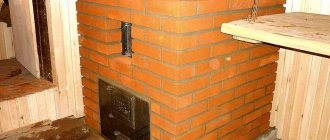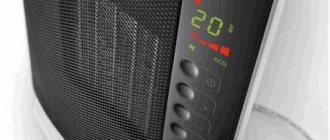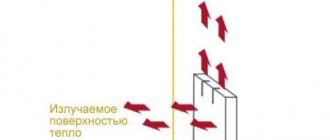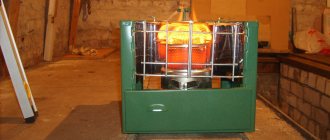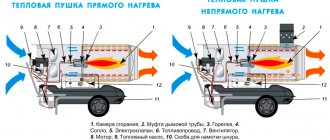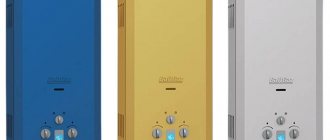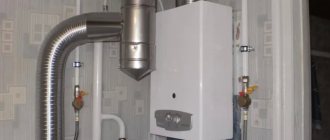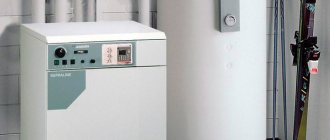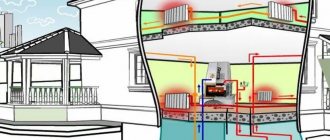| Place | Name | Characteristics in the rating |
| The best inexpensive energy-saving heaters: budget up to 3,000 rubles. |
| 1 | “Velvet Season” “Good Warmth” | The lightest and most convenient to transport |
| 2 | REDMOND SkyHeat 7003S | "Smart" convector with remote control |
| 3 | Ballu BEC/EZMR-1500 | Maximum heating area |
| 4 | Hyundai H-HV15-10-UI617 | Best asking price |
| 5 | Nikaten NT 200 | Stylish design |
| The best energy-saving heaters: budget over 3,000 rubles. |
| 1 | Polaris PMH 2085 | The best combination of power and heating area |
| 2 | Ballu BIH-AP4-1.0 | Minimum case thickness |
| 3 | Electrolux EIH/AG2-2000E | Combined technologies, increased functionality |
| 4 | Noirot Spot E-5 Plus 2000 | A large number of modes, protection against power surges |
| 5 | Timberk TEC.PF8 E 2000 IN | New with a front panel made of heat-resistant glass |
Video description
For an example of a test of quartz heaters, see this video:
Oily
Mineral oil is used as a heat transfer agent in special compartments with a heater. Thanks to this device, the radiator has sufficient inertia - it retains heat for a long time after being turned off.
Pros:
- Safety.
- Does not burn oxygen and does not dry out the air.
- Reasonable price.
- Does not cause unpleasant odors even when the surface is heavily dusted.
- Does not require maintenance.
Minuses:
- It takes a long time to heat up to the desired temperature.
- Available in floor-standing versions.
- Large mass.
Ceramic
They are thin ceramic panels containing heating elements. Unlike IR radiators, they work like regular heaters - they heat the entire room, and not just the areas exposed to radiation.
Advantages:
- Attractive design.
- Minimum energy consumption.
- Environmental Safety.
- Easy to install and operate.
- Fire safety.
Flaws:
- High price.
Assortment of ceramic radiators for the home Source del.at.ua
Ways to improve energy efficiency at home
You can reduce energy costs used for heating using different methods:
- increasing the energy efficiency of the building;
- the use of the Smart Home system, as well as other automation that allows minimizing costs;
- reducing electrical losses using radiators and other devices;
- increasing the efficiency of heating boilers or furnaces;
- using environmentally friendly types of energy (firewood, solar panels).
A combination of two or more options can be used to achieve better results.
Even the most reliable and high-quality heating system will not bring much benefit if large-scale heat loss occurs in the house, so measures should be taken to prevent heat energy from leaking through cracks and open vents.
It is important to take simple but effective steps by covering floors, walls, doors, ceilings, and window frames with thermal insulation material. In addition to insulation, additional insulation can be placed according to regulatory requirements. This will further reduce heat loss, thereby increasing the energy efficiency of the building.
To carry out high-quality thermal insulation, you can call a specialist energy auditor. He will carry out a thermal imaging survey of the house, which will reveal the places of the most intense heat loss, the insulation of which must be carried out first.
As a rule, the greatest heat loss occurs through the walls, the attic floor, and the floor along the joists. These areas require high-quality thermal insulation. To prevent heat loss through windows, you can use shutters that close at night.
Advantages of installations
Energy-saving installations for water heating are just beginning to gain popularity among Russians; they have appeared on the heating equipment market too recently. Of interest are high technical characteristics, environmental safety, autonomy, reliability, efficiency, and compactness.
- The efficiency of the EOU is 98% when two devices operate simultaneously in the heating system;
- the heating level is controlled by special temperature sensors;
- compact size and neat appearance;
- instant heating of the liquid in the chamber;
- there is no need to coordinate installation and subsequent operation with Gostekhnadzor authorities;
- significantly save owners money during the heating season;
- The guaranteed service life is 10 years, the operating period declared by the manufacturers is 30 years.
Advantages
SLO has high physiological properties. Low-temperature film electric heaters have a maximum temperature on the surface (40-45) ˚С, which provides radiation of an infrared heat flow of a soft long-wave spectrum. These rays do not heat the air, leaving its humidity natural.
They heat objects, floors, ceilings. At the same time, the speed of movement of convective flows decreases by an order of magnitude. When these rays hit the human body, they activate the human peripheral circulatory system, which causes the onset of a feeling of thermal comfort 2-3 °C earlier than with convective heating.
Confirmation of the positive physical properties is the information that such devices are used by English doctors to treat herpes, remove wrinkles on the face and for other cosmetic purposes. The high performance properties of the SLO are determined by a service life of more than 50 years. There are practically no maintenance costs required. The simplicity of installation technology is ensured by the absence of metal-intensive structures.
High design potential is ensured by the fact that radiant heat generators located on the ceiling can be covered with any elements of the ceiling design. The presence of a heating system is “signified” only by programmable regulators located on the walls. The innovation process both in the Russian Federation and abroad is mainly associated with the expansion of the use of natural gas, the installation of autonomous boiler houses, and the use of radiant gas systems.
The innovativeness (novelty) of the process under consideration is determined by the following components:
- The use of a radiant film electric heater that converts electricity into a stream of soft infrared radiation, which has physiological properties beneficial to humans.
- The use of a regulator that provides high-temperature conditions (20°C or other required temperature) only while people are in the room.
- The use of the thermophysical properties of the building corresponding to modern SNiP, which allows the formation of pauses in electricity consumption.
Essentially, this is heating to a new level. One of the main advantages of SLO is the virtual absence of operating costs and a long service life - up to 50 years.
The essence of energy saving
First, we want to reveal one little secret. You may be surprised, but any electric heaters are energy saving. After all, what does this term mean for a device that produces thermal energy? It means that the energy contained in fuel or electricity is converted by a boiler or heater into heat as efficiently as possible, and the degree of this efficiency is characterized by the efficiency of the unit.
So, all electrical appliances for heating rooms have an efficiency of 98-99%; not a single heat source that burns different types of fuel can boast of this indicator. Even in practice, so-called energy-saving electric heating systems emit 98-99 W of heat, consuming 100 W of electricity. We repeat, this statement is true for any electric heaters - from cheap fan heaters to the most expensive infrared systems and boilers.
Comparative example. On average, 1 kg of dry firewood emits 4.8 kW of heat during combustion, but in reality we can only get 3.6 kW, since the boiler efficiency is 75%. An electric heater is much more efficient, consuming 4.8 kW from the network and delivering 4.75 kW to the house.
A truly energy-efficient heating system is a heat pump or solar panel. But there are no miracles here either, these devices simply take energy from the environment and transfer it into the house, practically without consuming electricity from the network, for which you have to pay. Another thing is that such installations are very expensive, and our goal is, as an example, to consider available new market products that are declared as energy-saving. These include:
- infrared heating systems;
- induction energy-saving electric boilers for heating.
Energy efficient boilers and furnaces
To save energy from fossil fuels, it is worth replacing your traditional heater with an environmentally friendly and energy-efficient furnace (oil or gas) or heating boiler. In the first case, it is important to pay attention to the air duct system that distributes heated air throughout the rooms.
If the service life of the old boiler exceeds ten years, it is better to replace it with a modern model, the efficiency of which can reach 94 percent
When using boilers, it is also necessary to consider the communications through which the water will pass, heading to radiators or underfloor heating systems.
When choosing boilers or furnaces, it is important to consider the following factors:
- Availability of ventilation . A boiler or furnace equipped with a sealed combustion chamber must be blown by a flow of outside air. This prevents possible air pollution within the premises and reduces the likelihood of external air masses entering the house.
- Availability of electric ignition . Such models are considered much more effective than options with a pilot flame.
- Capacitive heat exchanger and condenser , which allow you to accumulate excess energy, which allows you to save on the production of new calories.
Modern furnaces and boilers, although they run on fossil fuels (fuel oil, propane), are still considered energy-efficient and environmentally friendly devices. For their operation, a minimum amount of fuel is sufficient, and the number of harmful substances released during combustion is negligible.
Recommendations for the operation of energy-saving heating devices
- Before connecting the device, you should make sure that the outlet is working properly.
You cannot connect several heaters to one outlet.
- The distance between the heating device and the interior items in the room should be at least half a meter.
- If the device is placed near a window, make sure that it does not come into contact with the curtains.
- Electric heaters should not be left on unattended.
- Heater vents must not be blocked.
Electric heater repairs are best left to a professional.
Basic selection rules
There are a lot of convector heaters on sale now. Pay attention to 4 main parameters:
- appearance;
- installation method;
- unit power;
- additional functionality.
Convector heaters are characterized by a wide variety of designs and dimensions. Before purchasing, decide where you want to install the device. Take measurements and select the appropriate device. To prevent the heater from being conspicuous, match its body to the design of the room.
The most common ways to install a convector: floor and wall. It is advisable to choose the latter if you plan to hang it under the window. Then the wall will not fog up. It is better to buy a floor-standing unit if you will be moving it around the room. Many electric heaters are equipped with wheels.
The required power of the heating device can be easily calculated based on the area you want to heat. To do this, remove 2 zeros at the end from the indicator. For example, a device with a power of 2500 W will heat an area of 25 m2 well.
The more expensive the convector, the more additional functions it has. Here's what functionality high-quality devices are equipped with:
- fall sensor – power automatically turns off after the device falls;
- timer – it is possible to automatically turn off the device after a specified time;
- thermostat - turns off the electric heater after reaching the required temperature in the room and turns it on when the air cools;
- Frost protection – automatic switching on of the convector when the temperature in the room drops below 7°C.
Considering these indicators when choosing a heater, you will get the best value for money.
Traditional heating optimization tools
Practice shows that the energy costs of heating systems are to a large extent determined by the quality of the project.
The layout of heating pipes, the installation points of heat-emitting panels, the performance of boiler installations - all this affects the consumption of electricity or fuel materials. Therefore, even at the stage of choosing a heating method, it is advisable to at least correlate the power of the installation with the requirements for heat transfer volumes. In addition, energy-saving heating based on conventional systems can be realized through the integration of automatic systems. They will help achieve rational consumption without user intervention by controlling operating modes. Date: September 25, 2022
Reduce costs with appliances
The most effective heating system is considered to be one that allows you to achieve comfortable heating at a minimum coolant temperature. To achieve this goal, it is best to use a water heated floor scheme.
This method is comfortable and hygienic, moreover, the structures are completely hidden from view, which allows you to combine warm floors with various types of traditional coverings: tiles, linoleum, carpet, parquet
Unfortunately, in harsh climates, heated floors are often unable to compensate for heat loss, especially if the house has large glazed spaces. This is explained by the fact that the maximum permissible temperature of the floor covering has a strict limit: it should not exceed +27°C.
The best option in this case is a combination of heated floors with modern radiators, which can be connected from below from the floor or wall, which allows you to exclude not very aesthetically pleasing pipe connections from the interior.
There is a huge range of radiators on sale, which differ not only in the manufacturer and type of device, but also in color, shape, and size. This allows you to find the optimal model to fit into the interior
Based on the principle of energy efficiency, it is better to focus on a collector-beam two-pipe radiator heating scheme. In this case, a special heating branch is installed in each room - a supply and return element.
Such a system allows you to maintain your own temperature in each room, minimally affecting the neighboring rooms.
Energy consumption and price range of different types of heaters
| Image | Type of heating device | Energy consumption, watt | Price range, rub |
| Infrared heaters | 50 W – 2 KW | 900 — 10 000 | |
| Convector heaters | 200 W – 2 KW | 1 070 — 11 500 | |
| Oil radiators | 200 W – 3.4 KW | 1 050 — 14 500 | |
| Ceramic heaters | 200 W – 18 KW | 3 000 — 24 000 | |
| Quartz heaters | 500 W – 6 KW | 2 500 — 22 000 |
The operating principle of modern electric heaters
All these devices are designed to solve the same problem, but they do not work on the same principle. There are three main ways in which heat transfer occurs:
- Natural convection method. It is based on the mixing of air masses. Cold air is denser and heavier than warm air, so it sinks down, giving way to the latter, which rises up. Most convection appliances have a radiator design.
- Long-wave radiation method. Devices operating on the principle of long-wave radiation (for example, infrared electric heaters) heat the walls and ceiling of the room, as well as objects located in it. Heating of the air occurs through warm surfaces.
- Thermal ventilation method. Fan heaters and heat guns operate on this principle. These devices include a heater and a fan. The heating element increases the temperature of the air passing through it, and then the heat flow is released into the room by a fan.
Combination devices that can be found in specialized retail outlets are also not uncommon. They are convection heaters equipped with fans.
Heatphone MT 1.5
The wall-mounted energy-saving heater for the home “Teplofon MT 1.5” increases the air temperature using the convector principle. It is possible to install legs with wheels, but they are not supplied.
The buyer can adjust the temperature using a wheel mounted on the top of the case.
Other advantages of the convector:
- presence of a bracket included in the delivery set;
- steel frame;
- simple but modern design;
- protected from overheating and moisture.
The dimensions of the device are 90x40x9.5 cm. Weight is 6 kg.
The convector is manufactured in Russia. The manufacturer provides a 3-year warranty.
The price of the device is from 3500 to 4000 rubles.
Examples of using installations
An energy-saving electrical heating system is an ideal option for trade stalls and pavilions located away from heating mains.
The use of electrical installations will have a beneficial effect on the condition of ancient buildings in historical parts of cities, where it is prohibitive to carry out expensive and labor-intensive work on laying thermal lines. After all, such mansions and ancient palace buildings are often surrounded by magnificent parks. In such cases, energy-saving installations may be the optimal solution to protect historical areas.
In city apartments, the EOU can be used as backup equipment. They will provide comfortable living on cold days, which are common in spring and autumn, when the heating is turned off. Russian winters are long and harsh; during particularly critical periods, when the centralized system does not provide adequate heat, EOUs will automatically warm the air to the required temperature.
EOU can be used as backup heating equipment in large rooms with insufficient thermal insulation, for example, in warehouses, production workshops, exhibition pavilions, concert halls and sports halls.
Almac IK5
Almak IK5 is an infrared energy-saving heater. It increases the temperature in the room by emitting waves of wavelengths invisible to the human eye. The heat is evenly distributed throughout the room. The floor temperature is only 1-2°C higher than the air at the level of human height.
The manufacturer assures that the service life of the device will be 20 years. Country of origin: Russia.
The power of the “IK5” model is 500 W. Therefore, the heater is suitable for heating small rooms. It is recommended to install it in the following premises:
- bathroom;
- hallway;
- bathroom;
- balcony.
This is one of the most budget devices in the TOP 10 ranking. The price of this energy-saving home heater is 2,690 rubles.
Heat pumps of two types
These designs are very popular. The device is considered the most efficient heating option because it is environmentally friendly. There is a type of heat pump called “mini-split”. It has an outdoor unit and one or more indoor units that supply both hot and cold air. There are two types of models on sale:
- Air source heat pumps. These are structures that have devices that, even at -20 degrees, take heat from external air masses and distribute it throughout the house through installed air ducts.
- Geothermal heat pumps. Devices with which you can use the energy of the soil. In the ground they are laid horizontally in rings at a depth of 1.5 meters, no less (freezing of the soil should be taken into account). Pumps can be installed vertically. For this purpose, wells are drilled to a depth of 200 m.
Although they run on electricity, the devices are energy efficient. Considering the costs, their efficiency is very high (1:3 for air, 1:4 for geothermal structures).
In addition, the units are environmentally friendly and absolutely safe. Another advantage of heat pumps is that they operate in reverse mode. They not only heat, but also cool the air. A geothermal device can be combined with a water heater, which will supply water up to +60 degrees.
RESANTA IKO-1500T
The heater "RESANTA IKO-1500T" works due to heat transfer by infrared radiation. The device is constructed in this way: an aluminum panel is placed in a thermally insulated steel casing. Thanks to this, the device is durable and safe.
Infrared rays warm up objects in the room, and they, in turn, give off heat to the air. Thus, the device consumes a minimum amount of electricity.
The heater of the Latvian brand “RESANTA” is designed for ceiling installation. Has the following characteristics:
- Size – 161.7 x 52.5 x 11.7.
- Weight – 3 kg.
- The power of the device is 1500 W, which allows it to heat 15 m2.
The manufacturer provides a 1-year warranty on the product. During this time, it can be repaired or replaced free of charge.
The price of the heater is 2500 rubles.
